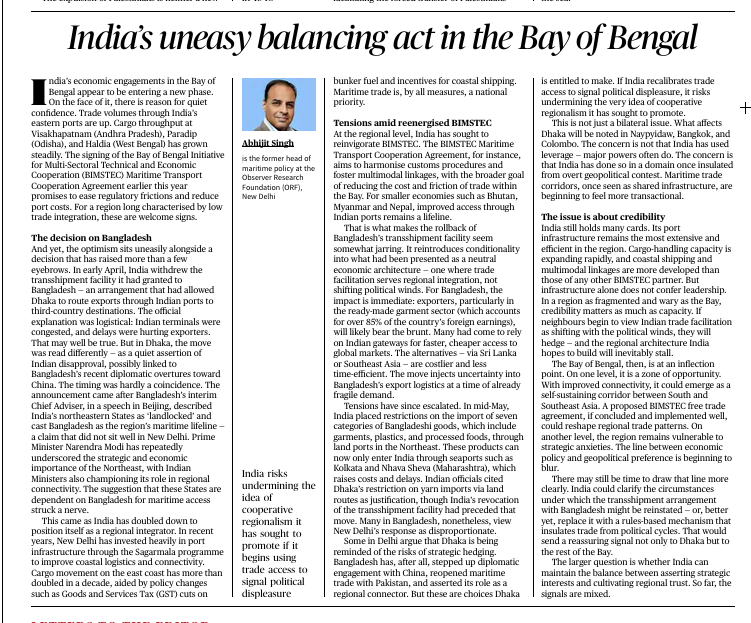I. Context and Background
- The editorial discusses India’s recent moves in the Bay of Bengal region and how they reflect a complex balancing act between regional cooperation, national interest, and strategic signalling, especially with respect to Bangladesh and BIMSTEC.
- India is actively building maritime infrastructure and engaging in subregional connectivity initiatives, but recent policy reversals — particularly the withdrawal of the transshipment facility to Bangladesh — have raised concerns about India’s consistency and intentions in regional diplomacy.
II. Key Developments Discussed
1. India’s Growing Maritime Infrastructure
- India’s eastern ports at Visakhapatnam, Paradip, and Haldia are being modernized.
- The BIMSTEC Maritime Transport Cooperation Agreement signed earlier this year aims to:
- Harmonize maritime customs procedures
- Lower port costs
- Facilitate regional connectivity
- Harmonize maritime customs procedures
- These moves align with India’s long-standing vision of boosting regional economic integration and trade connectivity.
2. Withdrawal of Transshipment Facility to Bangladesh
- India withdrew permission allowing Bangladesh to route cargo through Indian ports to third-country destinations.
- While officially described as a logistical move due to terminal congestion, it was widely interpreted in Dhaka as a geopolitical signal, particularly following Bangladesh’s growing ties with China.
- This move complicates India’s larger regional messaging and weakens confidence in India’s commitment to cooperative regionalism.
III. Strategic and Diplomatic Implications
1. India’s BIMSTEC Vision and Contradictions
- India has pushed for a “re-energized BIMSTEC”, advocating for shared regional infrastructure and integrated logistics across:
- Bangladesh
- Bhutan
- Nepal
- Myanmar
- Bangladesh
- However, the transshipment withdrawal contradicts this approach, suggesting a preference for bilateralism or strategic conditionality.
Implication: It undermines the neutral architecture India once championed and may push regional countries toward alternative hubs (e.g., Sri Lanka’s Hambantota or China-funded ports).
2. Bangladesh’s Response and Alternatives
- Bangladesh has been exploring:
- Chinese-built ports (e.g., at Payra)
- Connectivity with Southeast Asia through Thai and Myanmar corridors
- Indian rail/road connectivity for inland distribution
- Chinese-built ports (e.g., at Payra)
- India’s move risks signaling a transactional and unpredictable partnership, potentially reducing Dhaka’s long-term dependency on India for maritime trade.
IV. Core Argument and Author’s Perspective
- Abhijit Singh argues that India risks damaging its credibility in the Bay of Bengal by sending conflicting signals—investing in infrastructure and regional cooperation on one hand, while withdrawing access and imposing restrictions on the other.
- The need is for clear, coherent, and long-term policy, not reactive or strategic signalling, especially when China is actively expanding influence in the same space.
V. Broader Strategic Challenges
- Credibility and Perception
- India leads in port infrastructure but lacks clear leadership in regional consensus-building.
- The Bay is increasingly seen as a geo-economic and geopolitical battleground, and India’s inconsistent approach may undermine trust.
- Balancing Sovereignty with Leadership
- India must maintain a fine line between safeguarding strategic interests and appearing insular or self-interested.
- True leadership in the region means institutionalising openness, cooperation, and connectivity, even with countries having diverse alignments.
VI. Conclusion
India’s approach in the Bay of Bengal reveals the tensions between strategic signalling and cooperative regionalism. To sustain influence and leadership in this critical subregion, India must adopt a more consistent, principled, and inclusive maritime policy—one that balances its national interest with regional trust-building. Current mixed signals may endanger the very integration India seeks to lead.


